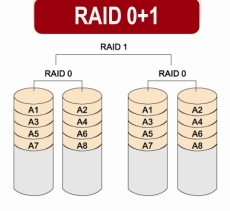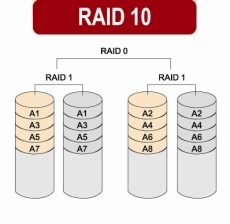現在 http://www.ithome.com.tw/itadm/article.php?c=47442 才知道原來 RAID 0+1 與 RAID 10 是不同的,
可是為何有些文件上的標題下的是 RAID 10 (0+1) 呢?
我已經搞不懂了
這邊的說法 http://www.pcguide.com/ref/hdd/perf/raid/levels/multLevel01-c.html
RAID Levels 0+1 (01) and 1+0 (10)
Description: The most popular of the multiple RAID levels, RAID 01 and 10 combine the best features of striping and mirroring to yield large arrays with high performance in most uses and superior fault tolerance. RAID 01 is a mirrored configuration of two striped sets; RAID 10 is a stripe across a number of mirrored sets. RAID 10 and 01 have been increasing dramatically in popularity as hard disks become cheaper and the four-drive minimum is legitimately seen as much less of an obstacle. RAID 10 provides better fault tolerance and rebuild performance than RAID 01. Both array types provide very good to excellent overall performance by combining the speed of RAID 0 with the redundancy of RAID 1 without requiring parity calculations.
另一個說法 http://net.csai.cn/store_Raid/200707251633131640.htm
RAID 0和RAID 1的組合稱為RAID 0+1,或稱為RAID 10
再來一個 http://www.accs.com/p_and_p/RAID/CompoundRAID.html
RAID-1+0
RAID Level 1+0 (also called RAID-10) is the result of RAID-0 applied to multiple RAID-1 arrays. This will create a very fast, stable array. In this array, it is possible to have multiple disk failures, without loosing any data, and with a minimum performance impact.
To recover from a failed disk, it is necessary to replace the failed disk, and rebuild that disk from its mirror.For two-drive failures, the probability of survival is 66% for a 4-disk array, and approaches 100% as the number of disks in the array increases.
RAID-0+1
RAID Level 0+1 is the result of RAID-1 applied to multiple RAID-0 arrays. This will create a very fast array. If the RAID-0 controllers (hardware or software) are capable of returning an error for data requests to failed drives, then this array has all the abilities of RAID-10. If an entire RAID-0 array is disabled when one drive fails, this becomes only slightly more reliable then RAID-0.
To recover from a failed disk, it is necessary to replace the failed disk, and rebuild the entire RAID-0 array from its mirror. This requires much more disk I/O than is required to recover from a disk failure in RAID-10. It should be noted that some enterprise-level RAID controllers are capable of tracking which drives in a RAID-0 array have failed, and only rebuilding that drive. These controllers are very expensive.For two-drive failures, the probability of survival is 33% for a 4-disk array, and approaches 50% as the number of disks in the array increases.
This RAID level is significantly less reliable than RAID-1+0. This is because the structure is inherently less reliable in a multi-disk failure, combined with the longer time to reconstruct after a failure (due to a larger amount of data needing to be copied). The longer time increases the probability of a second disk failing before the first disk has been completely rebuilt.
Quote: http://www.ithome.com.tw/itadm/article.php?c=47442
RAID 0+1
過程: 先用兩顆以 Stripe 方式作 RAID 0 再將兩組 RAID 0 作 RAID1
硬碟數: 4 顆以上偶數硬碟量
優點: 具效能與可靠性
比起單純的RAID 0,RAID 0+1在上層還有一層RAID 1的保護,除底層的兩組RAID 0同時各損壞1或2臺硬碟的情況以外,如果是某組RAID 0損毀1或2臺硬碟,系統都還能依靠另一組RAID 0維持運作。

RAID 10
過程: 先作 RAID1 再作 RAID0
硬碟數: 4 顆以上偶數硬碟量
優點: 可靠性 RAID 10較0+1略佳
使用: 除非底層兩組RAID 1發生其中1組的2顆硬碟同時損毀,才會完全失效。如果只是兩組RAID 1各損壞1顆硬碟,RAID 10還能維持正常運作。

留言